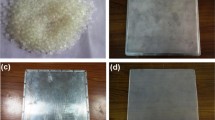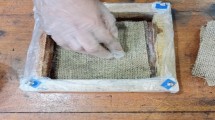Abstract
Climate change has been occuring in recent years. The extraordinary changes lead to high temperatures, floods, and typhoons that become a significant threat to people’s lives and property. Therefore, engineering methods have become important, as they decrease the level of people’s loss caused by natural disasters. Synthetic fibers have been commonly used in geotechnical engineering field since their invention, and are now widely available. Whether geotextiles are made using fabrics or nonwoven fabrics, water permeability and appropriate strength are their indispensable properties in reinforcement, separation, filtration, drainage, and protection. In this study, polyester (PET) filaments and nonwoven fabrics are combined using hot pressing, during which different weight amounts of filament are used. The composites are tested for delamination strength, tensile strength, tear strength, burst strength, and puncture strength to characterize the filament-based geotextiles. The experimental results show that a high needle punching depth has a negative influence on the strengths of geotextiles. Moreover, the geotextiles exhibit the optimal tensile and tearing strength when they are hot pressed at 170 °C, and optimal burst strength and puncture strength when they are hot pressed at 180 °C.
Similar content being viewed by others
References
S. C. Liu, C. B. Fu, C. J. Shiu, J. P. Chen, and F. T. Wu, Geophys. Res. Lett., 36, 1 (2009).
A. Rawal and M. M. A. Sayeed, Geotext Geomembranes, 37, 54 (2013).
E. M. Palmeira, A. F. N. Remigio, and M. L. G. Ramos, Geotext Geomembranes, 26, 205 (2008).
E. A. Subaida, S. Chandrakaran, and N. Sankar, Geotext Geomembranes, 27, 204 (2009).
ASTM D4439-11, Standard Terminology for Geosynthetics, 2011.
B. C. Chattopadhyay and S. Chakravarty, Geotext Geomembranes, 27, 156 (2009).
C. W. Lin and J. H. Lin, Text. Res. J., 75, 453 (2005).
B. C. Chattopadhyay and S. Chakravarty, Geotext Geomembranes, 27, 156 (2009).
T. T. Li and R. Wang, Text. Res. J., 82, 1597 (2012).
D. Cazzu and S. Venesia, Proc. 3rd Inter. Conf. Geotext., 3, 695 (1986).
C. T. Nguyen and T. V. Khanh, J. Mater. Sci., 39, 7361 (2004).
C. T. Nguyen, T. V. Khanh, and J. Lara, Theor. Appl. Fract. Mec., 42, 25 (2004).
A. Rawal, S. Lomov, and I. Verpoest, Int. J. Nonlen. Sci. Num., 11, 57 (2010).
C. C. Lin, C. W. Lou, and W. H. Hsing, AMRI, 55, 429 (2008).
C. W. Lou, C. C. Lin, and C. C. Huang, AMRI, 57, 239 (2011).
Y. Termonia, Int. J. Impact. Eng., 32, 1512 (2006).
Author information
Authors and Affiliations
Corresponding author
Rights and permissions
About this article
Cite this article
Lin, JH., Hsieh, JC., Hsing, WH. et al. Applications of geotextiles made of PET-filament-based nonwoven fabrics. Fibers Polym 17, 1955–1962 (2016). https://doi.org/10.1007/s12221-016-6833-9
Received:
Revised:
Accepted:
Published:
Issue Date:
DOI: https://doi.org/10.1007/s12221-016-6833-9




